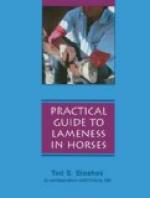The cul-de-sac of the capsular ligament of the fetlock joint which extends upward between the bifurcation of the suspensory ligament is the most frequently affected structure in this region. When distended, two spheroidal masses bulge laterally and anterior to the flexor tendons in a characteristic manner. This condition is known among horsemen as “wind-gall” or “fetlock-gall.”
The sheath of the flexor tendons, which begins about the middle portion of the lower third of the metacarpus, and continues downward below the pastern joint is often distended.
Excepting in cases of acute inflammation attending synovitis of these parts, no lameness marks its existence and in chronic cases of synovial distension the service of affected animals is not interfered with. These distensions constitute unsightly blemishes and they are treated chiefly for this reason.
No difficulty is encountered in recognizing these conditions even where considerable organization of tissue overlying distended thecae occurs. In such cases there may be only slight fluctuation of the enlargement, but if necessary, an aseptic exploratory puncture may be made with a suitable needle or trocar.
Treatment.—Complete rest and the local application of cold packs are in order in acute synovitis when there is distension of tendon sheaths. In the fetlock region, because of the ease with which pressure may be employed, the parts should be kept snugly wrapped with cotton, and derby bandages are used to exert the desired amount of pressure over the affected region. The pressure-bandages should be employed as soon as all acute and painful inflammation has subsided; and then they should be continued, day and night, for ten days or two weeks. The bandages should be removed morning and night. After the skin of the leg has thoroughly dried off, an infriction of alcohol or distilled extract of hamamelis is given the parts and the cotton and bandages are readjusted. A good, even and firm pressure in such cases is productive of satisfactory results.
[Illustration: Fig. 29—Distension of theca of the extensor of the digit (extensor pedis).]
In chronic distensions of tendon sheaths synovia may be aspirated and about five cubic centimeters of equal parts of tincture of iodin and alcohol is injected into the cavity. This is not done, however, without usual aseptic precautions. If no marked swelling results within forty-eight hours the entire fetlock region is thoroughly vesicated and, as soon as the skin has recovered from the effects of the vesicant, pressure bandages may be employed. In these cases, subjects may be put into service after all swelling which the injection or the vesicant has produced has subsided. The pressure bandages are used at night or during the time that the horse is in its stall and they are not worn by the subject while at work.
Where no marked swelling occurs within ten days, as the result of the injection of iodin, the injection may be repeated and, if thought necessary, the quantity may be materially increased. If swelling does not occur it is indicative that no particular irritation has been caused.




